Announced back in November, the 665p is Intel’s latest QLC SSD. Like its predecessor the Intel 660p, the 665p leverages QLC (quad-level cell) 3D NAND to lower the price of the SSD while only taking a moderate performance hit. The 665p is built off of Intel’s 96-layer NAND, the first QLC drive to hit the market in 96-layers. Like the 660p, the 665p is an M.2 SSD that leverages the NVMe interface and comes in 1TB and 2TB capacities.
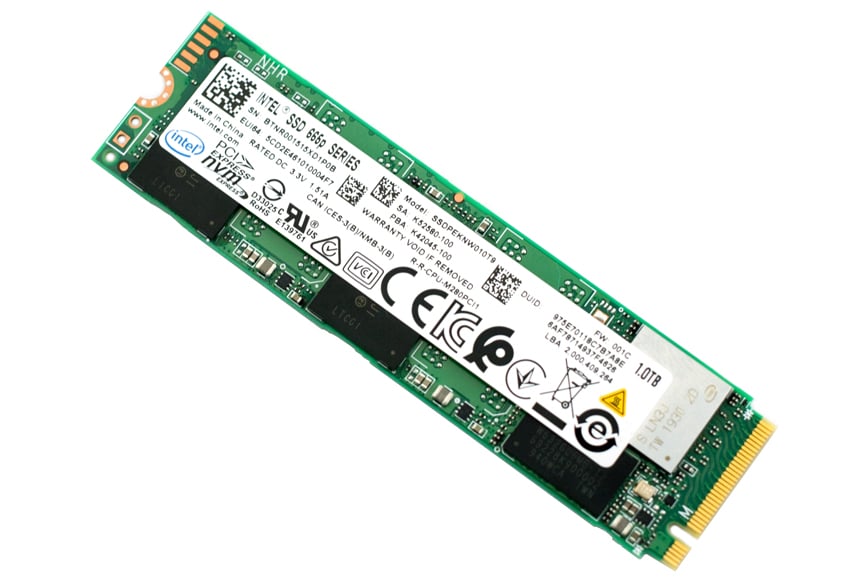
The Intel 665p is aimed at “everyday computing” as well as mainstream gaming. Like most M.2 form facto drives, it is aimed at notebooks, mobile devices, and desktop with the rest of the room taken up by something else. As stated, the drive leverages QLC. QLC stands for quad-level cells and is the next step beyond the already common triple level cells (TLC). As the name indicates, QLC packs in 4 bits per cell, one more than TLC. Alongside packing in 33% more bits per cell, we can reasonably expect a further decrease in write speeds and program-erase cycles as well as an increase in power consumption and error-rates; likely necessitating the development of new error-correcting code and controls.
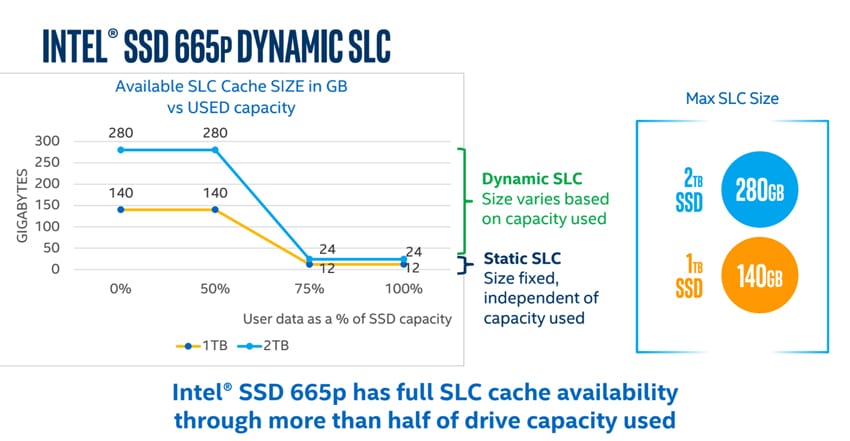
In our previous review of QLC technology, the drive, the Intel 660p, didn’t fair too well against the other drives in our comparison. The 665p comes with a 50% endurance bump and a modest performance bump, with top sequential speeds of 2GB/s read and write and random speeds up to 250K IOPS read and write. Part of the reason for the increased speed is the 665p’s dynamic SLC cache. The cache can grow or shrink to increase the speed of IO. The dynamic SLC cache also gives the drive its higher endurance.
We also have a video review for those that are interested:
The Intel 665p comes with a 5-year limited warranty and can be picked up today for $130 for the 1TB model, which we used for our review.
Intel SSD 665p Specifications
| Form Factor | M.2 2280-S3-M |
| Capacity | 1024 GB (1TB), 2048 GB (2TB) |
| Interface | PCIe 3.0×4, NVMe |
| Media | 96-layer, QLC, 3D NAND |
| Performance | Sequential Read: Up to 2,000 MB/s; Sequential Write: Up to 2,000 MB/s Random 4KB Reads: Up to 250K IOPS; Random 4KB Writes: Up to 250K IOPS |
| Endurance | 1TB: 300 TBW 2TB: 600 TBW |
| Power | Active: 100mW Idle: 40mW |
| Operating Temperature | 0° C to 70° C |
| Warranty | 5-year limited |
Performance
Testbed
The test platform leveraged in these tests is a Dell PowerEdge R740xd server. We measure SATA performance through a Dell H730P RAID card inside this server, although we set the card in HBA mode only to disable the impact of RAID card cache. NVMe is tested natively through an M.2 to PCIe adapter card. The methodology used better reflects end-user workflow with the consistency, scalability and flexibility testing within virtualized server offers. A large focus is put on drive latency across the entire load range of the drive, not just at the smallest QD1 (Queue-Depth 1) levels. We do this because many of the common consumer benchmarks don’t adequately capture end-user workload profiles.
Though we ran SQL Server on the Intel SSD 660p, the test is rather large and not friendly to QLC. That being the case, we decided to skip the test for this review and QLC reviews going forward.
Houdini by SideFX
The Houdini test is specifically designed to evaluate storage performance as it relates to CGI rendering. The test bed for this application is a variant of the core Dell PowerEdge R740xd server type we use in the lab with dual Intel 6130 CPUs and 64GB DRAM. In this case we installed Ubuntu Desktop (ubuntu-16.04.3-desktop-amd64) running bare metal. Output of the benchmark is measured in seconds to complete, with fewer being better.
The Maelstrom demo represents a section of the rendering pipeline that highlights the performance capabilities of storage by demonstrating its ability to effectively use the swap file as a form of extended memory. The test does not write out the result data or process the points in order to isolate the wall-time effect of the latency impact to the underlying storage component. The test itself is composed of five phases, three of which we run as part of the benchmark, which are as follows:
- Loads packed points from disk. This is the time to read from disk. This is single threaded, which may limit overall throughput.
- Unpacks the points into a single flat array in order to allow them to be processed. If the points do not have dependency on other points, the working set could be adjusted to stay in-core. This step is multi-threaded.
- (Not Run) Process the points.
- Repacks them into bucketed blocks suitable for storing back to disk. This step is multi-threaded.
- (Not Run) Write the bucketed blocks back out to disk.
The Intel SSD 665p landed near the bottom of our non-Optane SSDs with a score of 2,946.9 seconds, an increase from the 660p’s 4,070.6 seconds.

VDBench Workload Analysis
The peak 4K performance of the Intel SSD 665p stated below 100µs (20,762 IOPS at 66.2µs) and went on to peak at 207,299 IOPS at 616µs, well below the other drives in our pack.
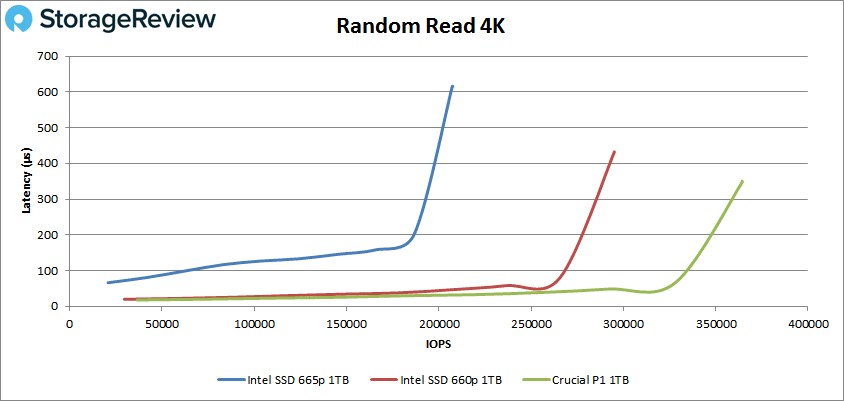
For 4K random write the 665p stayed in line with the other drives before peaking last at 221,249 IOPS at a latency of 572µs.
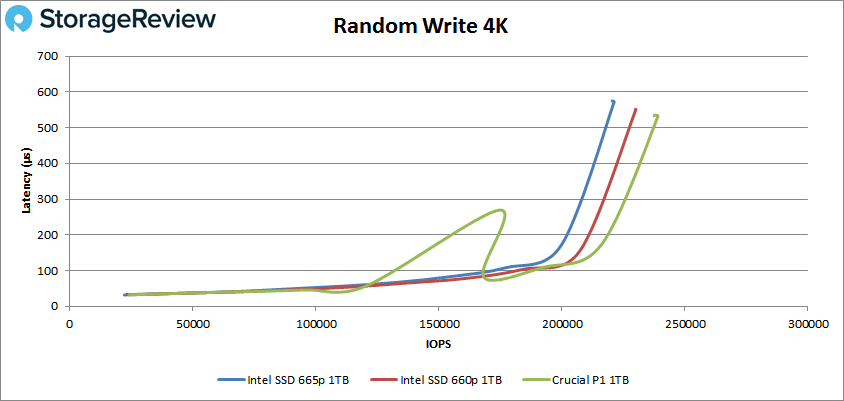
Switching over to sequential work, the 665p showed a much-improved performance with a peak of 20,530 IOPS or 1.28GB/s at a latency of 778.4µs in our 64K read. This blew past the other drives, placing the 665p at the top.
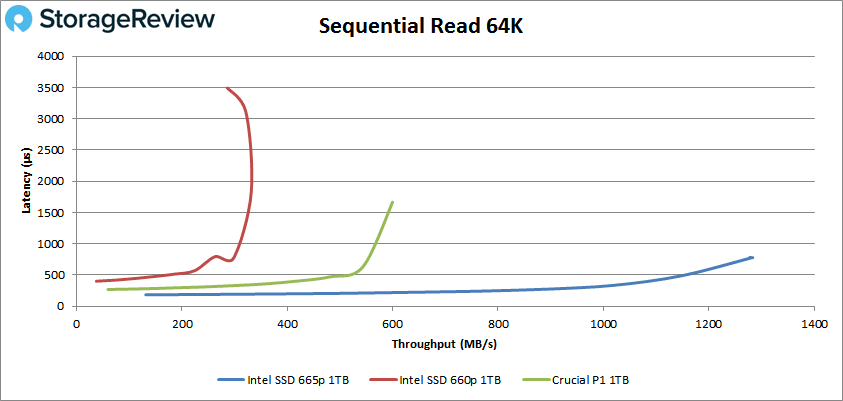
In 64K write the 665p continued to impress with a leader taking peak performance of 29,731 IOPS or 1.86GB/s at a latency of 532.2µs.
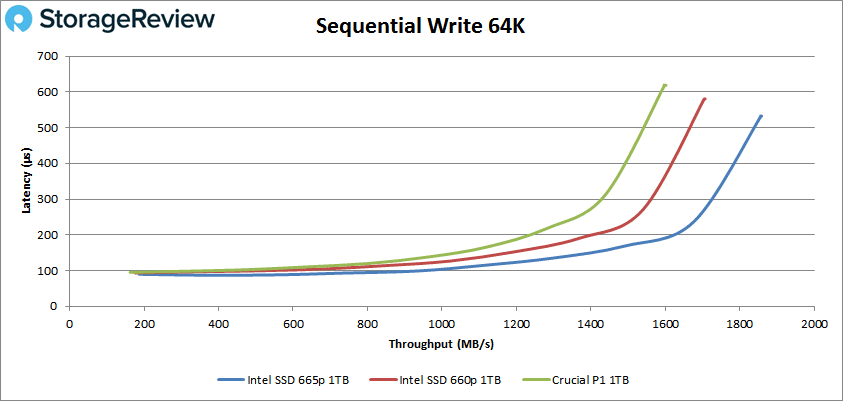
Next, we looked at our VDI benchmarks, which are designed to tax the drives even further. These tests include Boot, Initial Login, and Monday Login. Looking at the Boot test, the Intel 665p continued to shine peaking at 45,456 IOPS at a latency of 739.6µs before dropping off some. Again, the 665p took the top spot.
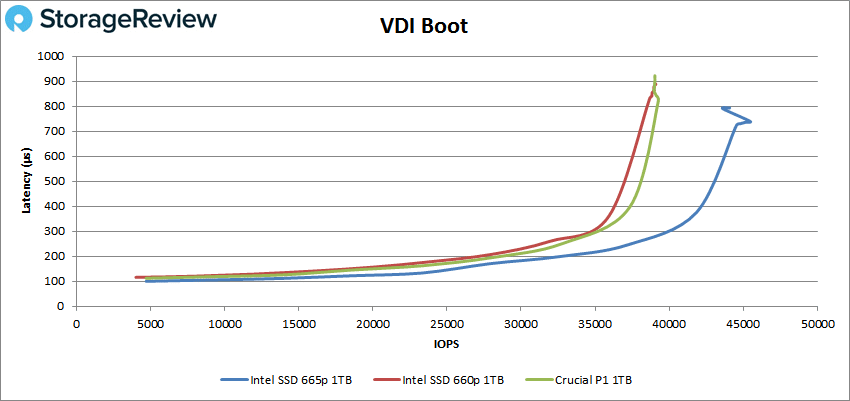
In our VDI Initial Login the 665p peaked at about 33,400 IOPS at roughly 800µs taking the top spot by some margin.
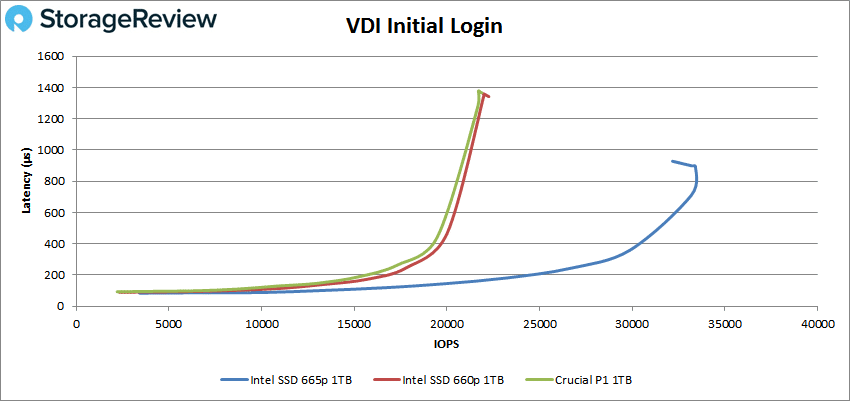
In our last test, VDI Monday Login, the 665p finished strong with a peak performance of 31,525 IOPS at a latency of 505.5µs.
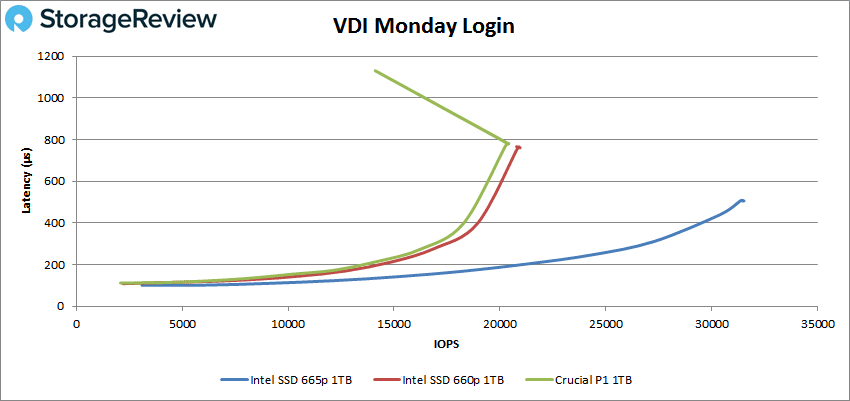
Conclusion
The Intel 665p is the company’s second release of QLC technology for end user computing (they do also offer QLC/Optane SSDs), this time with 96-layers. While their last attempt was an ok drive, it was a bit underwhelming. Noting this, Intel has devised a dynamic SLC cache to both improve performance and endurance. The drive comes in an M.2 form factor, up to 2TB of capacity, and is aimed at general everyday use.

Looking at performance, the Intel SSD 665p started off a bit rough in our VDBench coming in last in both 4K read (207K IOPS) and 4K write (221K IOPS) when compared to how the previous 660p performed. However, the SSD quickly went on to take the leading spot in all other tests hitting 1.28GB/s in 64K read, 1.86GB/s in 64K write, 45K IOPS in VDI Boot, 33K IOPS in VDI Initial Login, and 32K IOPS in VDI Monday Login. In Houdini the 665p was in the bottom quarter of the pack but showed an improvement over the 660p with 2,946.9 seconds.
The Intel SSD 665p shows some improvement over the 660p, however there is an issue with cost to performance. Currently the 665p can be purchased for $130 that is the same price one can pick up a higher-preformat drive for similar tasks. If the price of the 665p comes down it will make a fine general use drive. Intel will nonetheless be able to sell plenty of these guys to OEMs, along with their newer CPUs, aggressively pricing the all-Intel combination. End users that buy a value system with a 665p inside, will likely have a very good experience and won’t feel any bumps in performance, despite the hiccup in 4K.




 Amazon
Amazon